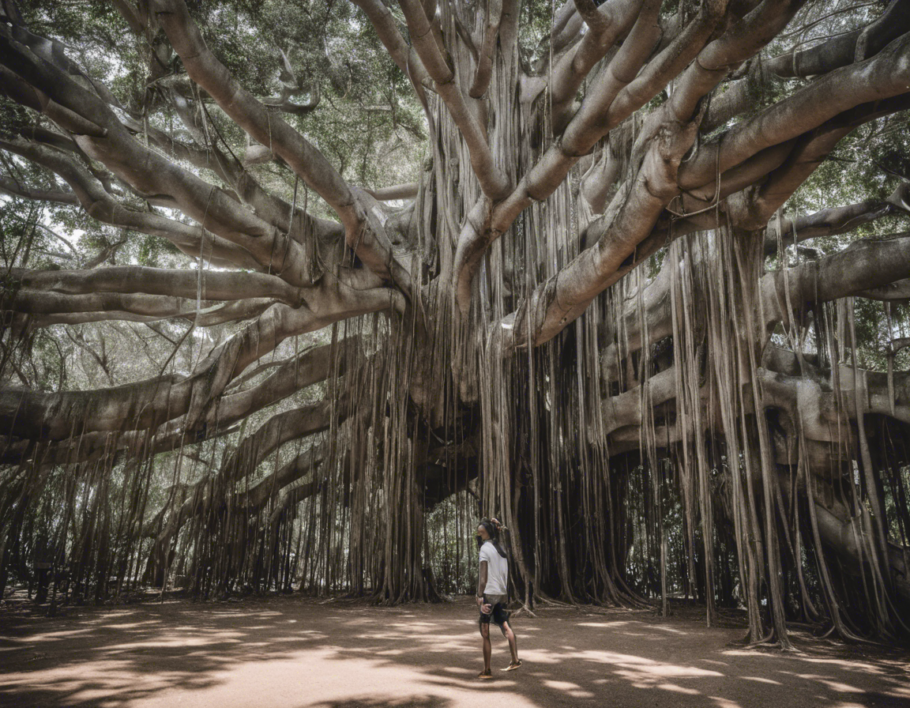Once upon a time, nestled in the heart of a lush tropical forest, stood a majestic Banyan tree. Its branches stretched out like welcoming arms, inviting all who dared to venture into its mystical embrace. This venerable tree, revered in many cultures for its symbolism of longevity and wisdom, held secrets and stories that whispered in the rustling of its leaves and the creaking of its branches. Join us on a journey as we unravel the wonders and mysteries of the Banyan tree – a true epitome of nature’s grandeur.
The Legend of the Banyan Tree
Legend has it that the Banyan tree is enchanted with divine powers, making it a sacred symbol in various mythologies. In Hindu mythology, it is believed that Lord Vishnu, the preserver of the universe, resides in the Banyan tree. The tree’s extensive roots symbolize the interconnectedness of all living beings, while its ever-expanding canopy represents the vastness of knowledge and spiritual growth.
Anatomy of a Banyan Tree
The Banyan tree (Ficus benghalensis) is not just an ordinary tree; it is an ecosystem in itself. Its aerial roots dangle like intricate curtains, forming new trunks when they touch the ground and take root. This unique growth pattern gives the tree a surreal appearance, with multiple trunks intertwined like a network of living sculptures. The heart-shaped leaves of the Banyan tree provide shade and shelter to a myriad of creatures, from tiny insects to nesting birds.
Cultural Significance
In many cultures across Asia, the Banyan tree is revered as a symbol of strength, resilience, and longevity. It is often a focal point for gatherings, rituals, and ceremonies, serving as a meeting place for the community to share stories and wisdom. The tree’s expansive canopy creates a natural sanctuary for meditation and contemplation, inviting seekers of inner peace and enlightenment to find solace beneath its branches.
Ecological Importance
Beyond its cultural and symbolic significance, the Banyan tree plays a vital role in maintaining ecological balance. As a keystone species, it provides food, shelter, and nesting sites for a diverse array of wildlife. Its extensive root system helps prevent soil erosion, while its dense canopy filters pollutants from the air, contributing to cleaner and healthier environments. By preserving Banyan trees in their natural habitats, we can protect entire ecosystems and ensure a sustainable future for generations to come.
The Healing Power of Banyan
Ancient healing traditions have long recognized the medicinal properties of the Banyan tree. Various parts of the tree, including the leaves, bark, and roots, are used in traditional Ayurvedic and folk remedies to treat a wide range of ailments. The leaves are known for their antidiabetic properties, while the bark is used to alleviate skin disorders and respiratory problems. Additionally, the aerial roots of the Banyan tree are believed to have antimicrobial and anti-inflammatory properties, making them valuable in natural healing practices.
Conservation Efforts
Despite their cultural and ecological importance, Banyan trees face threats from deforestation, urbanization, and climate change. Conservation efforts are crucial to preserving these ancient trees and the biodiversity they support. Initiatives such as protected areas, reforestation projects, and community education programs are essential in safeguarding the future of Banyan trees and the rich ecosystems they sustain. By raising awareness and promoting sustainable practices, we can ensure that these majestic trees continue to thrive for generations to come.
Exploring the Magic
Venturing into the enchanting world of a Banyan tree is an experience like no other. The serene whispers of its leaves, the dance of light filtering through its canopy, and the ancient wisdom echoing in its branches create a space for reflection, inspiration, and connection with the natural world. Whether you find yourself nestled beneath its sprawling roots or gazing up at its labyrinthine branches, the Banyan tree offers a glimpse into a timeless realm where nature and spirit intertwine in harmony.
FAQs
1. What is the significance of the Banyan tree in Hindu mythology?
In Hindu mythology, the Banyan tree is believed to be the abode of Lord Vishnu and symbolizes interconnectedness and spiritual growth.
2. How do Banyan trees contribute to the ecosystem?
Banyan trees provide food, shelter, and nesting sites for wildlife, prevent soil erosion, and help purify the air by filtering pollutants.
3. Are there any medicinal properties associated with the Banyan tree?
Yes, various parts of the Banyan tree, such as the leaves, bark, and roots, are used in traditional healing practices for their antidiabetic, skin-healing, and antimicrobial properties.
4. What are some threats to Banyan trees and their habitats?
Deforestation, urbanization, and climate change are among the key threats to Banyan trees and the ecosystems they support.
5. How can I contribute to the conservation of Banyan trees?
You can support conservation efforts by raising awareness, participating in reforestation projects, and adopting sustainable practices to protect Banyan trees and their habitats.

